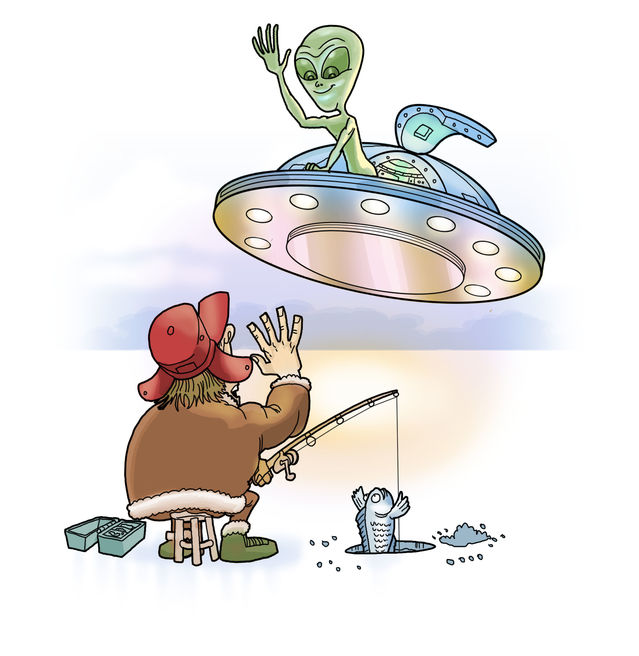Cognition
Why Won’t UFOs Go Away?
How critical thinking brings UFOs down to Earth
Posted February 6, 2020 Reviewed by Matt Huston

The idea that UFOs are buzzing around the Earth seduces many millions of hearts and minds. Why? To date, no one has presented credible and convincing evidence for scientific analysis and confirmation. After decades of claims, we have nothing. No confirmed contact, no wreckage, no bodies. All we have are inconclusive photos and videos and eyewitness accounts.
In fairness, UFO belief is not completely crazy because there is a reasonable possibility that intelligent life exists somewhere out there. Given the time, space and number of worlds in our universe, some say it’s likely. But here on our planet, at this moment in history, we have no compelling reasons to think that anyone has visited us. But people believe, nonetheless.
A Gallup poll found that 24 percent of Americans, 21 percent of Canadians, and 19 percent of Britons believe “extraterrestrial beings have visited Earth at some time in the past.” The National Council on Science and Technology and the National Institute of Statistics and Geography published a study that found as much as one-third of the U.S. population and 38 percent of Mexicans believe alien spaceships have been here.
To be clear, I’m not against the idea of aliens dropping by for a friendly visit. Nobody would love that more than me. Carl Sagan’s books and reruns of Lost in Space, The Twilight Zone and the original Star Trek series primed me very early in life to think outside the sphere. While normal kids were obsessing over sports heroes, I was imagining civilizations on faraway planets. I can still recall Charlton Heston’s words punching through my chest in childhood: “I can't help thinking that somewhere in the universe there has to be something better than man.”
As an adult, my fascination with the possibility of extraterrestrial life has not faded, though now I prefer the term astrobiology so it seems more respectable. I have seen strange things in the sky that I could not identify—twice. I once had a dream that included the Drake equation. So, given this background, why am I not a UFO believer?
Critical thinking, skepticism, and a deep appreciation for the scientific process have kept me grounded. Long ago I decided to cast my lot in with reality. And it’s worked out just fine. For me the Earth, galaxy, and universe are exciting enough, mysterious enough, ugly enough, and beautiful enough to accept as is. Unanswered questions frustrate me as much as anyone, but not so much that I’m willing to pretend to know things I don’t. So while I am not an ET believer, I remain filled with ET hope. If they ever do land here, the UFO believers will have to get in line behind me. Possible vaporization, enslavement, probing, radiation, or exotic pathogens won’t scare me off. First contact is mine; I’m going in.
Unidentified means unidentified. Many people have seen weird things in the sky that they cannot make sense of. But this is to be expected considering how crowded it can be with clouds, aircraft, balloons, flares, satellites, meteors, planets, and stars. A number of apparent sightings occur when people can’t resist jumping to extraordinary and unwarranted explanations. I can’t tell what that is—so it must be an extraterrestrial spaceship. This is a fundamental failure of critical thinking that is easily prevented by remembering that ignorance is not evidence.
Another important point to keep in mind is that credible evidence is something quite different from credible people. Actor Dan Aykroyd, for example, exemplified this mistake during an appearance on the Joe Rogan podcast. He repeatedly cited the credibility and apparent honesty of people who claim to have seen UFOs or been abducted by aliens. This suggests that honest, sober, and sane people see and remember everything with reliable accuracy. But we know better.
When anyone, including saints and Boy Scouts, report having seen something extraordinary, we must first consider the natural and normal fallibilities of human perception and memory. This applies not only to witnesses considered to be highly ethical and believable, but also to those with some degree of seemingly relevant expertise, such as professional/military pilots. They are human, too, which means their claims can’t always be trusted. Nothing personal: It’s a human thing. No amount of training, skill, talent, and professional experience make for an impenetrable firewall against misperception, illusion, hallucination, and faulty memories. Even the best human witness is still human.
Believing is seeing. None of us sees things as we feel we do. We assume that we are taking in the world around us as it really is. Not true. Our eyes receive reflected light from the things around us and then our brains do rapid translations or reconstructions of that information to present us with manufactured and highly edited images that we then “see” in our minds.
Another problem with human vision is that previous experiences and currently held beliefs can influence what we believe we see. Someone who already believes in ghosts, for example, is more likely to report seeing one in a dark room than someone who does not believe in them. Anytime you have a close encounter with a UFO eyewitness account, it’s fair and sensible to decide that it’s not enough simply because It has been shown many times in many experiments that the human vision system is not consistently accurate or reliable.
Don’t forget, memory is tricky. Add to this our challenges with memory. We do not record experiences video-camera style in our heads for later playback. The reality is that our brains cobble together stories about the past from varied bits of information. These stories are often highly edited and embellished, because their evolved purpose is not to provide us with an accurate transcript of the past but to give us information useful in the present or immediate future. Considering these challenges, how can we trust someone’s recollection of seeing an extraterrestrial spaceship in the sky last year, last week, or five minutes ago? For something as important and unusual as airborne aliens, we need more to make the case.
Many people are surprised to learn how easy is to misinterpret things in the sky. For example, an airplane approaching you from a distance can appear to hover even though it may be traveling at a high rate of speed. This might lead one to the incorrect conclusion that “it can’t possibly be a plane.” Should it then veer off to one side it might seem to have moved in an impossibly physics-defying way. Furthermore, some large planes can hover and then fly away. The U.S. military’s V-22 Osprey, for example, is capable of flying at speeds of more than 300 mph as well as hovering in one spot. An airborne Osprey at a distance or at night might move in ways that mislead an unaware ground observer.
Many military aircraft can eject flares that float down slowly on small parachutes to illuminate the ground below. Many planes and helicopters also use flares as defensive countermeasures. I have seen multiple flares deployed from aircraft that rapidly spiral away from the aircraft on independent trajectories. Several flares launched rapidly from a jet at night at high altitude could be very difficult to correctly identify from the ground, especially if the supersonic jet that deployed them is already long gone.
There is also the drone factor to consider. Militaries around the world are turning to UAVs (unmanned aerial vehicles) in increasing numbers. Some are large, some small, some fast, some slow. These aircraft don’t have to consider the frailties of a human pilot so the faster ones might maneuver in ways that seem impossible to a ground observer.
It’s raining UFOs. Every day, thousands of tons of rock and dust enter our atmosphere from space. Sometimes this constant shower of debris includes brief light displays as larger objects burn up. This can be misinterpreted. As pattern-seeking animals, we have a tendency to “connect the dots” in an attempt to identify things we see. The brain often forces this process even when the dots don’t naturally connect. This can lead people to see things that are not there.
We also have all the celestial bodies to consider. Venus, for example, can be very bright and low in the sky some evenings. To those unaware, it can look like a close spaceship rather than a distant planet. When you don’t know what you are looking at in the sky, size and distance are difficult, if not impossible, to determine. We can accurately estimate the size of birds and planes in the sky most of the time because we already know the size of birds and planes. We have a frame of reference to draw from. This is not the case for extraterrestrial spaceships, of course. An escaped birthday party balloon, for example, can seem like an enormous object if its identity and altitude are unknown. Remember this the next time you hear an eyewitness account of a colossal UFO.
Interest in the mysteries of space, including the possibility of extraterrestrial life, should be encouraged. But we don’t have to surrender our critical thinking to pursue these ideas. The impulse to believe doesn’t have to overwhelm our responsibility to think. I love science fiction. I look up and wonder. But I respect the real universe enough to try to live in it.
Recommended reading:
- Christopher Chabris and Daniel Simons. The Invisible Gorilla and Other Ways Our Intuitions Deceive Us. New York: Crown, 2010.
- David Darling, Life Everywhere: The Maverick Science of Astrobiology. New York: Basic Books, 2002.
- Paul Davies, The Eerie Silence: Renewing Our Search for Alien Intelligence, (Boston: Houghton Mifflin Harcourt, 2010
- Guy P. Harrison, 50 Popular Beliefs That People Think Are True, Amherst, NY: Prometheus Books, 2012.
- Guy P. Harrison, Good Thinking: What You Need to Know to Be Smarter, Safer, Wealthier, and Wiser. Amherst, NY: Prometheus Books, 2015.
- Stephen Macknik and Susana Martinez-Conde. Sleights of Mind: What the Neuroscience of Magic Reveals about Our Everyday Deceptions. New York: Henry Holt, 2011.
- Philip, Plait, Bad Astronomy (New York: John Wiley and Sons, 2002
- Benjamin Radford, Scientific Paranormal Investigation: How to Solve the Unexplained Mysteries. Corrales, NM: Rhombus, 2010.
- Carl Sagan, Pale Blue Dot: A Vision of the Human Future in Space. New York: Ballantine Books, 1997.
- Carl Sagan, The Demon-Haunted World: Science as a Candle in the Dark. New York: Random House, 1995.
- Robert Sheaffer, UFO Sightings: The Evidence. Amherst, NY: Prometheus Books. 1998.
- Robert Sheaffer, Bad UFOs: Critical Thinking About UFO Claims. 2015.
- Seth Shostak, Confessions of an Alien Hunter: A Scientist's Search for Extraterrestrial Intelligence. Washington, DC: National Geographic, 2009.
- Stephen Webb, If the Universe Is Teeming with Aliens . . . WHERE IS EVERYBODY?: Fifty Solutions to the Fermi Paradox and the Problem of Extraterrestrial Life. New York: Springer, 2010.
References
Linda Lyons, “Paranormal Beliefs Come (Super) Naturally to Some,” Gallup News Service, November 1, 2005, http://www.gallup.com/poll/19558/ paranormal-beliefs-come-supernaturally-some.aspx
Antonio Regalado, “Poll: Mexicans Express Belief in Spirits, Not Science,” January 5, 2011.




